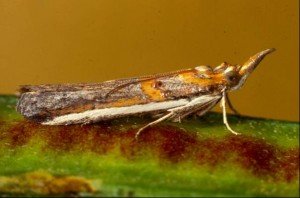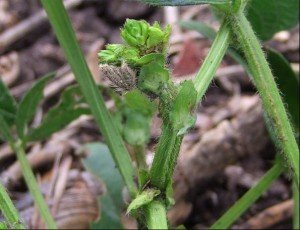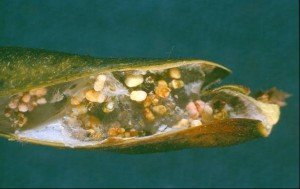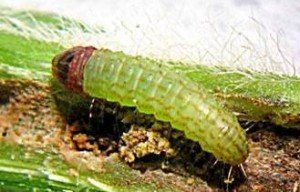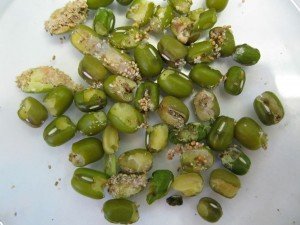There is an understandable level of concern about how best to manage etiella (Etiella behrii) in summer mungbean crops following the unexpectedly high etiella infestations (and corresponding seed damage and contamination) in spring mungbean crops on the Downs and in Central Queensland and North Western New South Wales.
Responding to the etiella threat without reacting prematurely and creating more pest problems.
It is unclear whether the etiella population will remain high and pose a major threat to the summer crop. Department of Agriculture, Fisheries and Forestry (DAFF) entomologist Hugh Brier and Technical Officer Adam Quade have recently (10 February) monitored soybean crops in the Branchview region, and mungbean crops (ranging from vegetative to early pod fill) in the Bowenville and Jimbour regions. This monitoring work included crops close to earlier-infested spring crops (now harvested). No significant or obvious etiella damage or moth activity was observed in these crops and unlike in 2014, etiella activity in January samples from the Branchview soybeans was extremely low. One point that needs to be made is that crops in the vegetative and flowering/early podding stages are at much lower risk of ‘surprise attack’ than crops at the late podfill stage. This is because the early signs of damage are manifested by dead or dying axilliary buds, whereas in podding crops, the pest’s presence is often not detected until larvae exit the pods just prior to pupation.
An early indication of etiella activity in mungbeans prior to budding/flowering is the number of moths visible in the canopy. If numbers are high, the moths will be easily visible flying in the crop as you walk through. Etiella moths are small, slender and grey with very pronounced, forward projecting mouthparts. The moths come to rest with their wings folded back along the body. The forewing has a distinctive white stripe along the leading edge (see image). A sweep net can be used to collect moths from the canopy for identification.
The other indicator of etiella activity is damage to the plant’s axilliary buds (the precursor to the floral buds). Damaged buds turn pale grey or straw in colour, and may be covered with fine webbing and frass.
As the floral budding stage approaches, be on the lookout for similar damage caused by bean podborer, the webbing and frass of which will be coarser/larger. Bean podborer have already been observed in spring crops in Central Queensland, and may continue to be active if favourable (rainy) growing conditions are experienced for the remainder of the mungbean growing season. Larvae of the two species, etiella and podborer, are quite different, the former being green/cream with pink stripes, and the latter very pale cream with numerous black spots.
Options and considerations for minimising etiella damage.
In southern Australia where etiella is a major pest of lentils, it is managed by spraying synthetic pyrethroids to kill moths when they are active in the crop. The timing of these treatments is guided by a model that predicts the start of etiella activity in spring. The synthetic pyrethroids provide short-lived knockdown of moths in the crop.
In a mungbean crop, the prophylactic use of synthetic pyrethroids increases the risk of flaring helicoverpa and mites because beneficial insects are killed off. Be aware that synthetic pyrethroids provide limited control of mirids because they have knockdown effect, but no residual control. The efficacy of synthetic pyrethroids on helicoverpa will also be limited by the level of resistance and size of larvae in the crop.
Where Altacor® is used for helicoverpa and/or podborer control in mungbeans, it might also be expected to give control of etiella larvae as they hatch and enter buds, flowers or green pods. The efficacy of Altacor® against etiella is currently being investigated by Hugh Brier. Altacor® has proven to be very effective against podborer feeding inside mungbean buds and flowers, so it is reasonable to predict it will also be effective against etiella larvae feeding inside buds and flowers.
However, once etiella are inside pods, DAFF trials and monitoring of etiella-infested spring crops suggest Altacor® (and most likely any other product) will have no impact on this pest. In contrast, trials suggest helicoverpa in podding crops will be controlled. This is because small larvae cannot penetrate pods and feed initially on buds/flowers, while larger larvae tend to move in and out of pods and are thus exposed to more insecticide.
If Altacor® proves to be effective in preventing the establishment of etiella larvae in flowers and pods, it will provide a more targeted and less disruptive option than prophylactically spraying crops to kill moths with synthetic pyrethroids.
Etiella seed damage, quality issues and thresholds
In late-podding mungbeans, etiella can partially damage as many as 4-5 seeds per pod. Many of these seeds are carried through into loads of harvested seeds delivered to the packing sheds. This results in grade outs and quality downgrades. In late podding soybeans the situation is simpler, as the majority of larvae eat only one seed, equating to about 0.2g/larva grain loss. As seeds are nearly totally consumed, the seed remnants are lost at harvest and the pest’s impact is mostly confined to yield loss. Threshold calculations for soybeans suggest theoretical thresholds are very high at 35-40 larvae per square metre, assuming larvae can be killed. The catch is that they won’t be killed once they are inside pods, so any thresholds in podding crops will have to be based on moth activity – watch this space.

